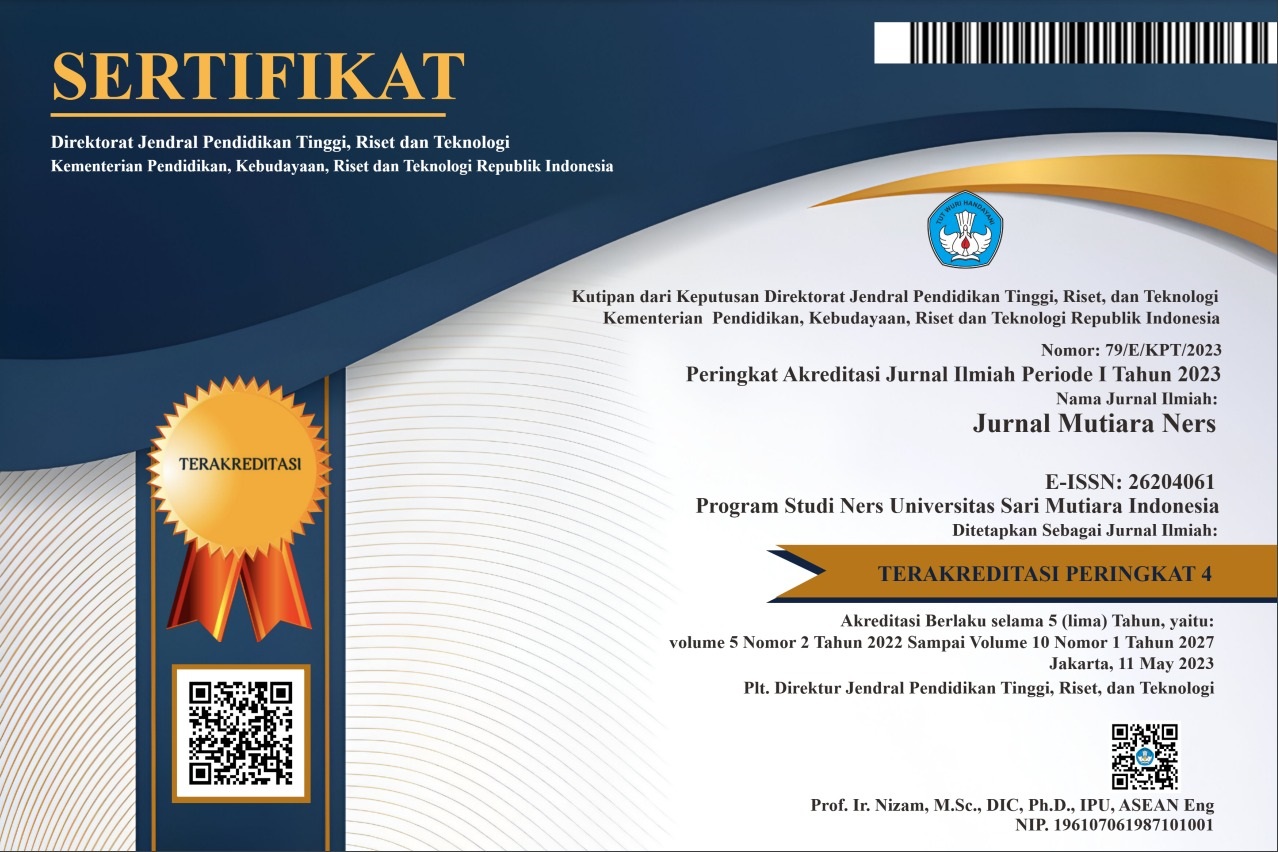ESA (EXERCISE AND SELF-AFFIRMATION) ON IMPROVING FUNCTIONAL STATUS OF HEMODIALYSIS PATIENTS
Keywords:
Intradialytic Exercise, Self-Affirmation, HemodialysisAbstract
The hemodialysis process is essential for patients with chronic kidney disease to maintain their lives. However, this routine and continuous process can cause complications in the body. Patients undergoing hemodialysis experience changes in functional status across physical, psychological, social, and environmental health domains. This study was carried out to determine the effect ESA (Exercise and Self-Affirmation) intervention on the functional status of patients with chronic kidney disease. Previous studies show that physical exercise combined with self-affirmation interventions can improve mood and cognitive function. Self-affirmation has been shown to reduce depression levels, improve sleep quality, enhance social participation, and ultimately improve the quality of life. This study used a quasi-experimental design with a pretest-posttest control group, involving thirty- nine patients in the control group and thirty-nine patients in the intervention group at the hemodialysis unit of PKU Muhammadiyah Yogyakarta. Functional status was assessed using the SF- 36 questionnaire and analyzed using paired t-tests for paired groups and independent t-tests for unpaired groups. The average SF-36 score before the ESA intervention was 44.53, and the average score after the intervention was 69.37. The t-test results showed a significance value of 0.000 (p<0.05). These results show a significant difference between the pretest and posttest results in the intervention group after the ESA intervention. In conclusion, the ESA intervention can improve the functional status of hemodialysis patients, so that their physical and mental function is better. The ESA intervention positively affects the functional status of patients with chronic kidney disease undergoing hemodialysis.
Downloads
References
Bayoumi, M. M., Saleh, J., & Wakeel, A. (2015). Research Article of Exercise programs on Hemodialysis Impacts Patients ’ Quality of Life and Physical Fitness. 23, 192–200.
Deoreo, P. B. (1997). Hemodialysis Patient -Assessed Functional Health Status Predicts Continued Survival, Hospitalization, and Dialysis- Attendance Compliance. 204–212.
Doran, D. M. (2011). Nursing Outcome, The State of The Science (J. &bartlett S. Canada, Ed.; Second Edi). Kevin Sullivan.
Legault, L., Al-khindi, T., & Inzlicht, M. (2012). Preserving Integrity in the Face of Performance Threat : Self- Affirmation Enhances Neurophysiological Responsiveness to Errors. https://doi.org/10.1177/0956797612 448483
LK, D. C. johansen. (2012). Barriers to exercise participation among dialysis patient. Nephrol Dial Transplant, 27: 1152-1157.
Melia, Putrayasa, A. (2008). Hubungan Antara Frekuensi Kemoterapi Dengan Status Fungsional Pasien Kanker Yang Menjalani Kemoterapi Di RSUP Sanglah Denpasar.
Musyarofah, R. (2013). Perbedaan kepatuhan Minum Obat Sebelum dan Setelah Afirmasi Positif Pada Penderita TB Paru di Puskesmas Gribig Kabupaten Kudus. JIKK, 4(2), 59–69.
Nuraini, D. (2015). Pengaruh latihan Fisik Terhadap Fatigue Pada pasien Intrahemodialisis di RSUD Tugurejo semarang.
Orti, E. S. (2010). Exercise in haemodialysis patients : a systematic review. Revista Nefrologia, 30(2), 236–246.
Ouzouni, S., Kouidi, E., Sioulis, A., Grekas, D., & Deligiannis, A. (2009). Effects of intradialytic exercise training on health-related quality of life indices in haemodialysis patients. Clinical Rehabilitation, 23(1), 53–63.https://doi.org/10.1177/026921550809676
Riskesdas Kepulauan Bangka Belitung 2018. (n.d.).
Rumentalia Sulistini, Krisna Yetti, T. S.H. (2012). Faktor – Faktor Yang mempengaruhi fatigue pada Pasien Yang Menjalani Hemodialisis. Jurnal Keperawatan Indonesia, 15(juli), 75–82.
Shan, Y., Lee, C., Ashman, T., Shang, A., & Suzuki, W. (2014). Brief report : Effects of exercise and self- affirmation intervention after traumatic brain injury. 35, 57–65. https://doi.org/10.3233/NRE-141100
Smeltzer, S.C., Bare, B.G., Hinkle, J.L., Cheever, K. H. (2010). Brunner and Suddarth’s Text Book of Medical Surgical nursing ((!!th ed)). Lippincolt Williams & Wilkins.
Sulistyaningsih, D. R. (2011). Efektivitas Latihan Fisik selama Hemodialisis terhadap Peningkatan Kekuatan Otot Pasien Penyakit Ginjal Kronik di Rumah Sakit Umum Daerah Kota Semarang.
Takhreem, M. (2008). The effectiveness of intradialytic exercise prescription on quality of life in patients with chronic kidney disease. In Medscape J Med (Vol. 10, Issue 10, p. 226
Published
How to Cite
Issue
Section
Copyright (c) 2024 Adiyati Mardiyah, Anggorowati, Andrew Johan , Ummi Maktum, Erna Julianti

This work is licensed under a Creative Commons Attribution-ShareAlike 4.0 International License.


.png)





